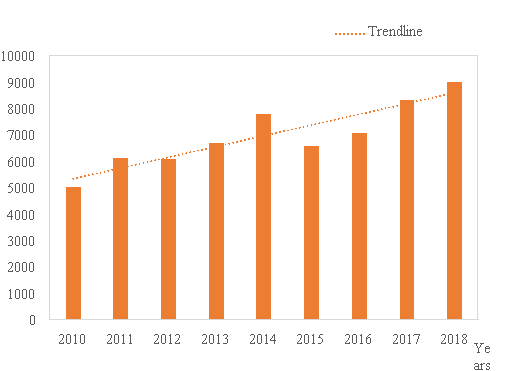In the modern market economy, the State plays an important role in regulating the economic development in order to achieve stable, efficient and equitable state.
State budget funding is a financial activity with great influence on macroeconomic targets such as productivity, employment and economic growth. Through decision on funding scope and structure, State budget funding exerts direct influence on allocation of financial resources for specific socioeconomic targets pursued by the State.
Present Vietnam fishery infrastructure has been subject to serious downgrade due to severe natural conditions. Every year, Vietnam suffers more than 15 storms, which causes effect to the fishery infrastructure [1]. Meanwhile, annual refurbishment funding remains quite limited, which directly affects fishery exploitation and business.
State budget funding for fishery infrastructure development has an impotant role for socioeconomic aspect; reducing loss after harvesting and increasing commodity value; promoting offshore exploitation development and other effects. The Vietnamese government issued a lot of decrees and policies for fishery development. In this paper, state budget investment in building fishing ports and fishing berths; state budget investment in storm shelters for fishing boats and state budget investment in fishery exploitation logistics will be mentioned.
Actuality of fishery development and the meaning of investment in fishery infrastructure
Vietnam has 3.260 km coastline with 112 estuaries and 4.000 islands of various sizes, creating many channels and lagoons, ensuring diversified fishery resources [2, 3]. Vietnam coastal regions have high biological regeneration capability and maritime environment is relatively clean. Therefore, fishery is found safe for health — a leading advantage in the world’s present fishery market. Thanks to this advantage, Vietnam has become one of the world’s big fishery exporting countries.

Fig. 1. Vietnam fishery export turnover from 2010 to 2018
Vietnam’s fishery turnover increased equally through years. In particular, in 2018, export turnover of Vietnam reached the highest level, i.e. 9 billion USD. Vietnam now ranks first in the Southeast Asia, second in Asia and fourth in the world in terms of fishery export. Vietnam seafood has been exported to more than 170 countries in the world, including EU, Japan, USA, Korea, China and Australia.
Such outcome is attributed to the fact that Vietnam owns favorable position in fishery exploitation and production. However, fishery resources have been greatly exhausted due to extreme nearshore exploitation. To overcome this situation, the Government plans to encourage offshore exploitation in order to limit depletion of resources.
For offshore exploitation plan to be implemented, first of all, fishery infrastructure must be invested and developed by the State. Specifically, fishing ports and berths should be invested and built; storm shelters for fishing boats and logistics service should also be paid attention to.
Solutions to improve investment efficiency for fishery infrastructure
First, it is important to make plan and invest in building storm shelters, fishing ports and fishery wholesale markets inside industrial parks and fishery services uniformly and adequately, creating favorable conditions for exploitation, processing and production. However, the State investment is insufficient. The State put forth funding options for phases but actual funding achieved only about 30 % of the set plan. This indicates the serious lack of funding from the State budget. Therefore, it is necessary to call for investment capital out of the State budget for fishery infrastructure.
It is important for the Government to negotiate with the organizations that can fund fishery industry in general and infrastructure in particular. Some typical funding sources are the World Bank and Asia Development Bank. Besides, it is advised to set up ODA and FDI attraction programs and projects; participate in bilateral and multilateral activities to attract funding from other countries, international organizations and nongovernmental organizations.
Fishery infrastructure may also be invested by the State in the form of Build — Operate — Transfer (BOT) Contract. Specifically, contracts shall be signed by and between the State and investors to build infrastructure; after the works are completed, the investors are entitled to operate the works in a definite term; when this term expires, the investors must transfer such works to the competent State authority. This option requires strict management and supervision by the State, otherwise it will lead to excessive collection and cause difficulty to fishery fishing forces.
Second, it is necessary to fund enterprises and fisher households to build service fishing boats with high capacity so that fishers shall be entitled to sufficient services such as timely fishing boat, fishing equipment repairing and petroleum, ice water, food and foodstuff supply in order to improve offshore fishing capability.
Third, actual State investment policies remain rampant and dispersed. Specifically, many fishing ports and fishing berths are now overloaded. Meanwhile, many fishing ports and fishing berths have no operating boats. One solution is to transfer purpose of use. In other words, such fishing ports and berths may be changed into tourism ports in order to create revenue and spend such revenue investing uniformly in necessary fishing ports and fishing berths.
Forth , at present, fishery infrastructure is downgraded seriously due to severe weather conditions. This urgent matter must be treated immediately. Every year, infrastructure must be repaired, upgraded, refurbished and managed strictly and effectively. This matter requires the State funding in spite of limited present funding because Vietnam is a poor country. However, such maintenance and upgrading will be more effective if strict supervision is applied to avoid capital loss due to corruption.
Conclusion
In this article, the authors also put forth solutions to improve investment efficiency for fishery infrastructure. Solutions and their significance will be analyzed in subsequent researches.
References:
- Planing and development of aquaculture of the central provinces until 2020, orientation to 2030. General report. Hanoi: Institute of Fisheries and Planning, 2015, 30p.
- Overview of seafood industry. Available at: https://voer.edu.vn/m/khai-quat-ve-nganh-thuy-san/889dd772 (accessed: 01.03.2020).
- Vietnam seas and islands. Available at: https://theleader.vn/bien-va-hai-dao-viet-nam-qua-cac-con-so-20170520115445015.htm (accessed: 01.03.2020).







